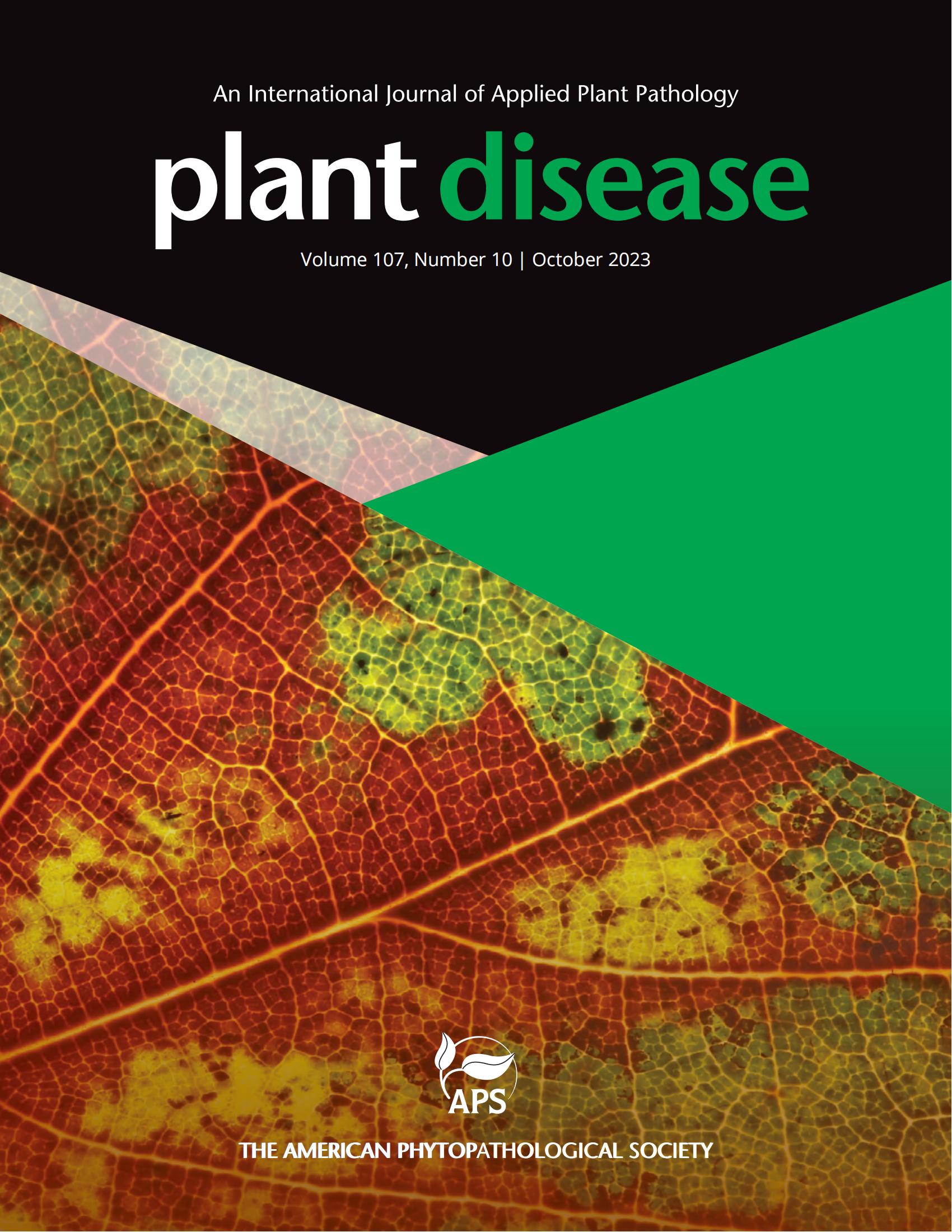中国引起异叶树树皮开裂的新宇宙孢子虫首次报道。
摘要
菠萝蜜(Artocarpus heterophyllus)是桑科的一种乔木,其果实具有多种药用和营养价值,在中国被广泛种植。2022年6月,在云南河口2400亩果园(E103°52′39″N22°34′14″)发现了严重的菠萝蜜树皮开裂病。这种病主要危害树干和树枝。发病率约90%,植物死亡率高达50%。症状最初表现为有牙龈的小水斑。随后树皮腐烂开裂,木质部逐渐变成褐色(图1),最终感染部位的上枝枯萎死亡。随机选取50个典型症状的躯干,分别用75%酒精溶液和3%过氧化氢溶液对感染组织的小段5×5 mm进行表面消毒,用无菌水冲洗3次,置于含有50mg/L青霉素的PDA培养基上。培养皿在25 ~ 28℃的暗处保存。在马铃薯葡萄糖琼脂(PDA)上连续分离到镰刀菌样菌落,获得15个单分生菌株。在PDA上,菌落呈现白色和蓬松的气生菌丝。主菌丝宽达5.5µm。微分生孢子透明,镰状,尺寸为4.50-9.00×2.30-4.00µm (av.6.50×3.15µm, n=50)。具有分隔的大分生孢子为9.00-11.50×3.05-5.25µm (av.10.50×4.15µm, n=50),基底细胞呈足形,逐渐变细至钩状的顶细胞(图2)。这些形态特征与Fusarium sp.相似(Sun et al ., 2018)。为了进一步鉴定,对分离物BLM1和BLM2的内部转录间隔区(ITS)、RNA聚合酶II亚基(RPB2)和翻译延伸因子1- α (tef1)基因序列进行扩增,分别用ITS1/ITS4、RPB2- 5f2 /RPB2- 7cr、EF-1/EF-728R引物对进行测序(Weir et al, 2012),并将序列提交GenBank (ITS: PQ394640和PQ394641, RPB2: PQ416997和PQ416998, TEF: PQ416999和PQ417000)。Blast结果表明,BLM1和BLM2序列与前型CBS 125729 (NRRL 46517)具有较高的同源性(ITS: 548/553(99%);微软:456/466 (98%);RPB2: 823/823(100%)) (Sandoval-Denis等,2019)。多相鉴定结果显示,与伪链球菌CBS 125729、CBS 130.78、NRRL22354、LC13838 (https://www.fusarium.org/Poly%20ID%20Fusarium)序列相似度在98%以上。基于ITS-TEF-RPB2组合序列数据,采用多位点数据集的最大似然(ML)方法,使用MEGA 7进行系统发育分析,结果表明BLM1和BLM2与假剑虫聚类(图3)。以2棵5年生的健康菠萝蜜树和10棵1年生的幼苗进行致病性测试。以PDA培养基或无菌水作为对照接种3株植株。幼苗在温室(25℃,70%相对湿度,12 h明暗循环)中培养,树木在田间培养,重复试验3次。树干接种部位用无菌水冲洗,表面用酒精消毒,用消毒针轻微损伤,接种含有菌丝和孢子的真菌团,接种孢子悬浮液10µL (1 × 105个分生孢子/ml)。接种7 d后,树干出现白色浆液流出,树干出现轻微开裂和腐烂,而对照组树干未出现症状。通过对ITS、TEF和RPB2基因的测序,重新分离并鉴定出该病原体与原分离物一致(Pereira et al ., 2019),这是中国乃至世界范围内首次报道的引起a . heterophyllus树皮开裂的病原菌。树皮开裂病严重影响了菠萝蜜的种植,为防治菠萝蜜树皮开裂病提供了理论依据。Jackfruit (Artocarpus heterophyllus) is a tree of the Moraceae family and widely cultivated due to its fruit with diverse medicinal and nutritional properties in China. In June 2022, a serious bark cracking disease was observed on jackfruit in the 2400-acre orchards of Hekou, Yunnan (E103°52'39″ N22°34'14″). The disease mainly harms tree trunks and branches. The incidence rates were about 90% and the mortality rate of plants reached up to 50%. Symptoms initially appeared as small watered-spots with gumming. Subsequently the bark rotted and cracked, the xylem gradually turned brown (Figure 1). Ultimately, the upper branches of infected parts withered and died. Small 5×5 mm segments of infected tissue from 50 randomly selected trunk with typical symptoms were surface sterilized with 75% alcohol solution and 3% hydrogen peroxide solution respectively, rinsed three times with sterile water, and placed onto PDA medium with 50mg/L of penicillin. The plates were kept at 25 to 28 ℃ in the dark. Fusarium-like colonies were consistently isolated on potato dextrose agar (PDA) and 15 monoconidial isolates were obtained. On PDA, colonies exhibited white and fluffy aerial mycelia. Main hyphae are up to 5.5 µm wide. The microconidia were hyaline, falcate, measuring 4.50-9.00×2.30-4.00 µm (av.6.50×3.15 µm, n=50). Macroconidia with septation were 9.00-11.50×3.05-5.25 µm (av.10.50×4.15 µm, n=50) with foot-shaped basal cells, tapering to hooked apical cells (Figure 2). These morphological characterizations were similar to Fusarium sp. (Sun et al, 2018). For further identification, the internal transcribed spacer (ITS) region, RNA polymerase II subunit (RPB2) and translation elongation factor 1-alpha (tef1) genes sequence of isolate BLM1 and BLM2 were amplified and sequenced with primer pairs of ITS1/ITS4, RPB2-5F2/RPB2-7CR, EF-1/EF-728R respectively (Weir et al, 2012), The sequences were submitted to GenBank (ITS: PQ394640 and PQ394641, RPB2: PQ416997 and PQ416998, TEF: PQ416999 and PQ417000). Blast results showed the sequences of BLM1 and BLM2 had high identity to these of Neocosmospora pseudensiformis (Anamorp: Fusarium pseudensiformis) ex-type CBS 125729 (NRRL 46517) (ITS: 548/553(99%); TEF: 456/466(98%); RPB2: 823/823(100%)) (Sandoval-Denis, et al 2019). Polyphasic identification showed above 98% sequence similarity to N. pseudensiformis CBS 125729, CBS 130.78, NRRL22354, LC13838 (https://www.fusarium.org/Poly%20ID%20Fusarium). Phylogenetic analysis using MEGA 7 based on the combined ITS-TEF-RPB2 sequence data, employing the maximum likelihood (ML) method for the multi-locus dataset, showed that BLM1 and BLM2 clustered with F. pseudensiformis (Figure 3). Two five-year-old healthy Jackfruit trees and ten one-year-old seedlings were used for a pathogenicity test. Three plants were inoculated with PDA medium or with sterile water as an experimental control. The seedlings were cultured in a greenhouse (25℃, 70% relative humidity, 12 h light and dark cycle) and the trees cultured in the field, and the experiment was repeated three times. The inoculation sites on trunk were rinsed with sterile water, surface disinfected with alcohol, slightly wounded with sterilized needles, and inoculate fungal masses containing mycelium and spores, as well as 10 µL of spore suspension (1 × 105 conidia/ml). Seven days after inoculation, white slurry effluent as well as minor cracking and rotting of the trunks were observed on the trunks, whereas no symptoms were observed on the trunks of the controls. The pathogen was reisolated and identified by sequencing the ITS, TEF, and RPB2 genes as being consistent with the original isolates N. pseudensiformis has been reported as a pathogen of fruit rot on Passiflora edulis (Pereira et al, 2019), and this is the first report causing bark cracking on A. heterophyllus in China as well as worldwide. Bark cracking disease had seriously affected jackfruit cultivation, and the report provides an knowledge for the prevention and control of this disease.

 求助内容:
求助内容: 应助结果提醒方式:
应助结果提醒方式:


